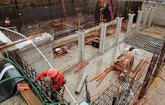Interested in Inspection?
Get Inspection articles, news and videos right in your inbox! Sign up now.
Inspection + Get AlertsLike many cities, Seattle, Wash., has had its share of problems with combined sewer overflows (CSOs) and sanitary sewer overflows (SSOs). In 2012, more than 154 million gallons of raw sewage and stormwater spilled into the water bodies around the city.
However, a unique consent decree lodged in July 2013 integrates stormwater control into the plan to address water-quality improvements. That agreement allows Seattle Public Utilities the discretion to address stormwater control projects ahead of some CSO projects where it can demonstrate greater environmental benefit.
Seattle has been actively battling CSOs since the 1960s. In simple terms, this is the city’s current strategy to control CSOs, SSOs and stormwater:
1. Fix it first — repair damaged infrastructure that’s causing problems.
2. Keep stormwater out of the system.
3. Store whatever water is left.
The consent decree between the city, the Environmental Protection Agency (EPA), the Department of Justice, and the Washington State Department of Ecology will substantially reduce CSOs. Under the decree, Seattle is committed to spending $500 million on capital improvements between 2010 and 2025 to reduce CSOs to meet current water quality standards.
At the helm is Seattle Public Utilities (SPU), established in 1997 as a merger between four city departments, Water, Solid Waste, Drainage and Wastewater, and Engineering Services.
Stormwater versus CSOs
“Before this consent decree, nobody had compared the effectiveness of controlling stormwater runoff as compared to working directly on CSOs,” says Susan Stoltzfus, strategic advisor, communications and public involvement, SPU. “In Seattle, the magnitude of the effect of stormwater runoff on the water environment can be 100 times greater than the effect of the relatively small volumes of CSOs entering the same water body. By using this approach, it gives SPU more flexibility in meeting the intent of the Clean Water Act and the terms of the consent decree.”
Seattle CSOs usually occur following several days of rain or during very intense storms, while stormwater runoff discharges happen every time it rains and in much higher volumes.
“As many as 6 million gallons of stormwater runoff can discharge into local waterways in a 24-hour period,” says Stoltzfus. “And in Seattle, CSOs are often 90 percent stormwater. By assessing the environmental impact of stormwater runoff, we can demonstrate which projects make the most sense for us to pursue first.”
SPU’s analysis indicates that stormwater runoff could introduce more fecal coliform bacteria into the environment than many CSOs. Roadway pollution and contaminants only add to the problems.
“The sources of contamination include polluted runoff, leaky side sewers and even homeless campers emptying sewage holding tanks into storm drains,” said Stoltzfus. “Seattle also has more dogs than children and failing to pick up after pets appears to be a huge contribution.”
The consent decree requires the development of a methodology and benchmarks that will compare the effects of targeting CSOs versus targeting stormwater alone on both humans and the environment. A draft plan, which models and estimates total suspended solids and other typical water-quality parameters, is due in 2014.
Fixing it first
The three-part strategy for dealing with CSOs, SSOs and stormwater predates the consent decree. SPU remains committed to “fixing it first.”
“The worst CSO offender in the city is at Salmon Bay with 88 overflows and 57 million gallons of untreated stormwater and sewage overflowing in 2012,” says Stoltzfus. “Obviously we’re going to fix that first, while possibly deferring the smaller projects.”
The Seattle consent decree explicitly references SPU’s Capacity, Management, Operation and Maintenance (CMOM) program, which represents part of the “fix it first” strategy. The utility must file an annual CMOM report to the EPA.
“We have a very advanced asset management program and establishing its effectiveness was part of the consent decree negotiation,” says Frank McDonald, maintenance planning & scheduling manager, SPU. “We had to demonstrate that we were getting the same or better results than other utilities regarding CSOs and SSOs, and that allowed us the flexibility to continue with our current program.”
McDonald’s group is responsible for wastewater system assessment, including CCTV work and inspection and analyzing inspection results. The group prepares repair or rehabilitation work orders for in-house crews and work packages for public works contracting. It maintains an active program to keep inflow and infiltration under control.
“We’ve collected a lot of data on various asset classes and have a good knowledge of how we expect those assets to perform, according to pipe material, pipe diameter, manufacturer, age and how and where the pipe was installed,” says McDonald. “Some asset classes are in better shape than others and we’re looking at how to address any gaps.”
SPU utilizes five in-house CCTV trucks outfitted with CUES cameras employing Granite XP software. Four are committed to regular inspection, while a fifth is used by first responders for system emergencies. SPU crews perform about 90 percent of all CCTV work.
Between Granite XP and the city’s Maximo CMMS/EAM software, the team prioritizes the work that needs to be done on wastewater assets.
“We have three crews devoted to repair and rehabilitation, who complete about one-third of our rehab work,” says McDonald.
Outside contractors perform work 18 feet or deeper requiring specialized shoring and work occurring near high-pressure gas and steam lines, or fiber optic cables. Cured-in-place and trenchless work is contracted out, while in-house crews perform most manhole maintenance, including grout work and relining.
“Ultimately, it’s our job to know whether we’re cleaning pipes at the right intervals, focusing our maintenance effectively and doing the right amount of replacement and rehabilitation,” says McDonald. “We’re doing what we can to reduce contributions to SSOs and CSOs that are within our control.”
Keeping stormwater out
Seattle is engineering natural drainage and water retention features at several locations around the city. Green stormwater infrastructure includes trees, bio-retention facilities, permeable pavement, green roofs, rainwater harvesting and bio-retention planters. These features allow stormwater to be absorbed rather than taking up capacity in the sewage system or creating polluted runoff.
Developers often work with SPU to maximize the effectiveness of green stormwater infrastructure according to the City of Seattle Stormwater Code. City departments are required to meet the same code if its requirements are triggered by their projects.
The city recently worked with developer Vulcan Real Estate to add stormwater control features to a new development along Lake Union, including a series of rain gardens planted along the street. Vulcan is paying $1.2 million of the $4.12 million price tag of the “Swale on Yale” project, which will filter up to 180 million gallons of stormwater annually.
Storing what’s left
Lake Washington is a recreational lake, frequently used for swimming and boating. Because of its potential for human contact, the water body has been identified as a high priority for action.
Work is already underway to protect Lake Washington by constructing five underground sewage storage tanks. The Windermere Basin Sewage Overflow Prevention Project involves the construction of a 2-million-gallon concrete underground storage tank. A new 2,250-foot-long gravity sewer and a parallel force main are being installed using a combination of open cut and trenchless construction techniques.
“We had a difficult time finding a location for this massive tank,” says Stoltzfus. “We were constrained by the need to be as close to the shoreline as possible and the desire to minimize construction impacts on a busy arterial street.”
The storage tank is scheduled to go online between two and five years from now.
Engaging the public
One of the further requirements of the consent decree is public education. SPU offers citizens the opportunity to monitor CSO activity on its website, with alerts and estimated discharge volumes updated every 10 minutes.
“It’s a way to raise public awareness,” says Stoltzfus. “It’s very difficult to make people aware of overflows that are happening underwater, 100 yards offshore. This brings the fight against CSOs home to them in real time.”










